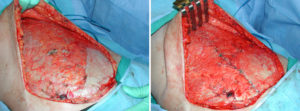Background: A tummy tuck is one of the most well known of all body contouring procedures. Its name is synonymous with the understanding that a variably-sized segment of tissue is removed and a low abdominal scar results. It is viewed as the ultimate abdominal reshaping operation that is a far step beyond that of less invasive liposuction.
While the tummy tuck is an excision of loose skin and its attached fat, an essential step is often done to the muscle as well. Known as ‘muscle tightening’ its actual purpose and execution is a bit different. With stretching out of the abdominal wall which contains the midline rectus muscles from the underlying influence of a growing fetus, the normal bowstring effect of the muscle from the ribcage down to the pelvis becomes stretched out. This contributes to an abdominal protrusion or pooch. This is one of the three contributors to excessive abdominal fullness. (loose skin, extra fat, loose /lax muscle)
Tightening back the abdominal wall, or muscle tightening, is done by a technique known as fascial plication. By bringing together the two sides of the enveloping fascia by a vertical row of midline sutures, the muscle protrusion is reduced and helps the abdomen get flatter.



Fascial plication is seen as an integral part of a tummy tuck procedure. While invaluable in treating the third level of an abdominal protrusion is most women, it is always done. If the preoperative examination shows no significant abdominal wall laxity or in men who have a tummy tuck after weight loss, fascial plication may not be necessary.
Case Highlights:
1) Many tummy tucks have fascial plication as an integral part of the procedure.
2) Fascial plication reduces abdominal wall protrusion/laxity by vertical shortening the rectus muscles.
3) Fascial plication is done up to and around the umbilicus but must leave room for it to survive.
Dr. Barry Eppley
Indianapolis, Indiana



